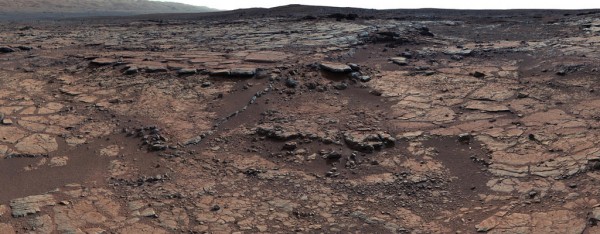Curiosity Rover Photos Reveal Proof of Fossilized Life on Mars
| Ana Verayo | | Jan 08, 2015 09:10 AM EST |
(Photo : NASA/JPL-Caltech/MSSS ) This mosaic of images from Curiosity's Mast Camera (Mastcam) shows geological members of the Yellowknife Bay formation.
A new and more in depth study of the Curiosity rover's images of Mars report that ancient sedimentary rocks on Mars have similar structures and microbes to those here on Earth.
These findings suggest the photos could be considered as evidence of ancient life on Mars. This doesn't prove anything about early life on the Red Planet, however.
Like Us on Facebook
NASA's Curiosity has taken thousands of photos of Martian terrain over the years. Among these photos are those of the Gillespie Lake outcrop in Yellowknife Bay, which is a dry lakebed that went through seasonal floods billions of years ago.
Scientists believe Mars and Earth share the same evolutionary process that took billions of years. Basic organisms found on Earth can be described as mat-like colonies that were home to minute microbes in underwater sediments such as lake beds and coastal regions.
These cellular structures are called microbially-induced sedimentary structures (MISS) and are found all over the world. MISS reveals the Earth's ancient evolutionary history.
MISS that are believed to be 3.48 billion years-old and indigenous to Australia's Dresser Formation are the oldest evidence of life on the Earth, according to Nora Noffke, a geobiologist from the Old Dominion University in Virginia. She spent the last 20 years studying these microbial organisms.
Noffke further details the similarities between MISS found on Earth and the Martian sedimentary structures found in the Gillespie Lake outcrop, which is about the same age as Earth's, or 3.7 billion years-old.
The report describes striking features that are both similar to one another. These features include pockets, domes pits and even chips and cracks from a few centimeters to kilometers in length.
This still isn't solid proof or evidence about ancient life on Mars. There also isn't enough ample proof these microbial structures were indeed shaped by biological processes.
This confirmation can only be made by returning Martian rock samples back to Earth for intensive analysis.
This study was published in the journal, Astrobiology.
TagsCuriosity Rover Photos Reveals Proof of Fossilized Life on Mars, NASA, Curiosity Rover, Mars, curiosity rover photos mars, life on mars, proof of life on mars, fossils on mars, NASA curiosity rover mars photos fossils life
©2015 Chinatopix All rights reserved. Do not reproduce without permission
EDITOR'S PICKS
-

Did the Trump administration just announce plans for a trade war with ‘hostile’ China and Russia?
-

US Senate passes Taiwan travel bill slammed by China
-

As Yan Sihong’s family grieves, here are other Chinese students who went missing abroad. Some have never been found
-

Beijing blasts Western critics who ‘smear China’ with the term sharp power
-

China Envoy Seeks to Defuse Tensions With U.S. as a Trade War Brews
-

Singapore's Deputy PM Provides Bitcoin Vote of Confidence Amid China's Blanket Bans
-

China warns investors over risks in overseas virtual currency trading
-

Chinese government most trustworthy: survey
-

Kashima Antlers On Course For Back-To-Back Titles
MOST POPULAR
LATEST NEWS
Zhou Yongkang: China's Former Security Chief Sentenced to Life in Prison

China's former Chief of the Ministry of Public Security, Zhou Yongkang, has been given a life sentence after he was found guilty of abusing his office, bribery and deliberately ... Full Article
TRENDING STORY

China Pork Prices Expected to Stabilize As The Supplies Recover

Elephone P9000 Smartphone is now on Sale on Amazon India

There's a Big Chance Cliffhangers Won't Still Be Resolved When Grey's Anatomy Season 13 Returns

Supreme Court Ruled on Samsung vs Apple Dispute for Patent Infringement

Microsoft Surface Pro 5 Rumors and Release Date: What is the Latest?










